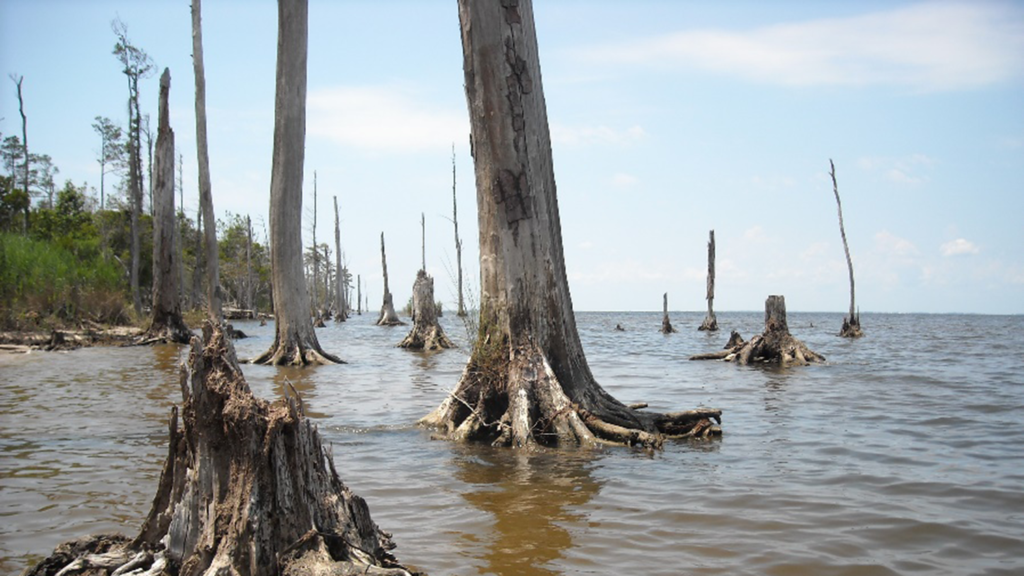Some Birds ‘Win’ and Some ‘Lose’ with Sea Level Rise, Expert Says
Global sea level rise is accelerating every year due to climate change, and it could threaten the very existence of some coastal bird species.
High tides are becoming higher because of sea level rise, allowing storm surges to push saltwater farther inland towards saltwater marshes and upland forests.
When saltwater floods these coastal ecosystems, it can cause significant changes to the vegetation that birds rely on for food and shelter.
“If you want to understand how sea level rise affects birds, you have to begin by looking at how it affects plant communities,” said Chris Moorman, a professor of fisheries, wildlife and conservation biology at NC State.
Moorman, whose research focuses on conserving wildlife in the face of global change, added that the compositional and structural characteristics of plant communities determine the kinds of birds that live within an ecosystem.
Sea level rise is accelerating at such a rapid rate that it could submerge most of the world’s saltwater marshes by 2100, leaving many of the birds that have historically relied on these ecosystems without habitat.

As sea levels rise, the plants in saltwater marshes can “migrate” inland into adjacent forests or wetlands as they seek ideal growing conditions, unless they encounter barriers such as development and agriculture.
“Marsh birds are caught between rising sea levels and land uses that can act as barriers to marsh migration,” Moorman said. “If marsh migration isn’t allowed to happen, these birds could become extinct locally because they won’t have anywhere to go.”
For example, the Eastern black rail — a sparrow-sized black bird that inhabits marshes along the Atlantic Coast — has already experienced population declines of more than 75% over the last two decades, in part due to habitat loss related to sea level rise.
Eastern black rails rely on the higher, drier parts of marshes. It is currently thought that sea level rise is causing tidal flooding to inundate high marsh, pushing black rails into areas that are less suitable.
“It’s important that we find ways to promote marsh migration amid rising sea levels so that birds like the Eastern black rail have places to move inland,” Moorman said.

A 2019 study conducted by Moorman and Paul Tallie, a former doctoral student who is now an assistant professor at UNC Chapel-Hill, showed that the transformation of forests into marshes can benefit some birds of conservation concern.
When saltwater inundates coastal forests, it kills trees, leaving behind large patches of dead snags known as “ghost forests.” Those snags provide habitat for cavity-nesting and bark-foraging birds like red-headed woodpeckers.
Saltwater inundation also causes vegetation to shift closer to the ground, with salt-tolerant shrubs and grasses eventually replacing the dead trees of ghost forests. This creates habitat for northern bobwhite quail and other birds that require dense understory vegetation.
Other birds that rely on closed-canopy forests, such as Acadian flycatchers and hooded warblers, permanently lose habitat when forested wetlands and upland forests transform into ghost forests.
The habitat losses and gains associated with sea level rise are small compared to those resulting from wildfire and other disturbances, but once coastal forests convert into marshes, the transformation — and its impacts on wildlife — are permanent.
“As with any disturbance, there’s always winners and losers following marsh migration,” Moorman said. “It’s the responsibility of land managers to recognize that and to weigh the costs and benefits of their actions so they can maximize their conservation objectives, ideally for rare and threatened species.”

Moorman suggested that land managers work to begin transitioning vulnerable forested areas to marsh, allowing more time for the transition to occur before inundation from sea level rise.
Land managers can facilitate marsh migration by harvesting overstory trees or applying high intensity prescribed fires, according to Moorman. Both approaches can reduce tree cover and allow marsh grasses to move inland more rapidly.
“We also need to plan long term to conserve areas that allow for marshes to migrate. That certainly means avoiding new developments within those planned pathways,” Moorman said.
This post was originally published in College of Natural Resources News.